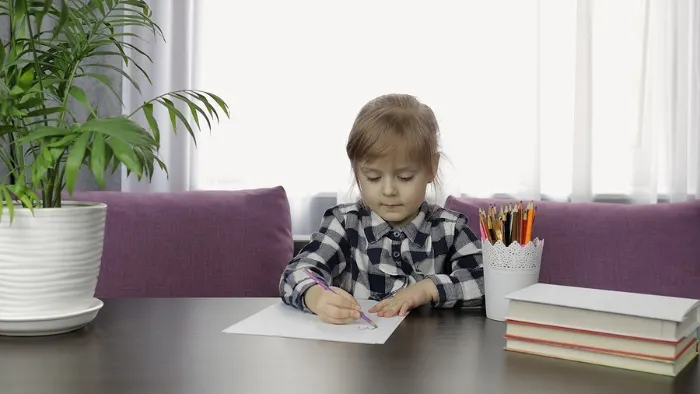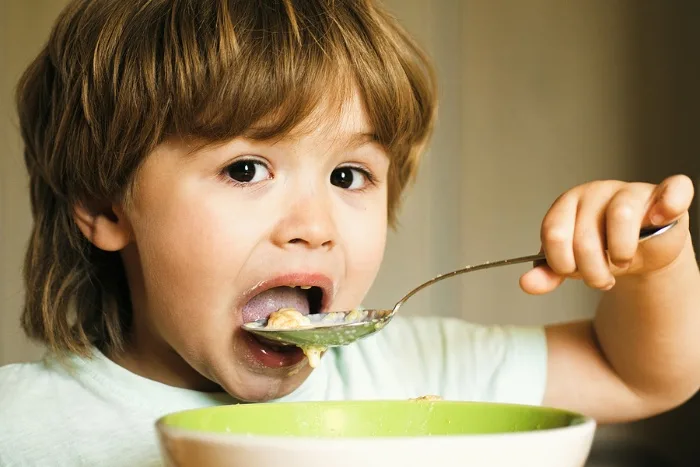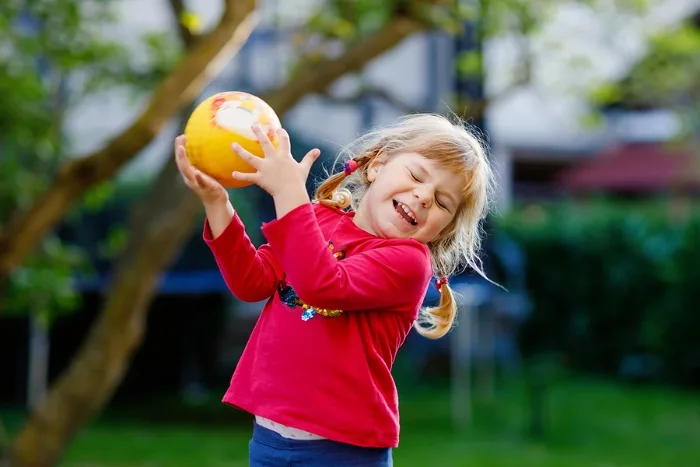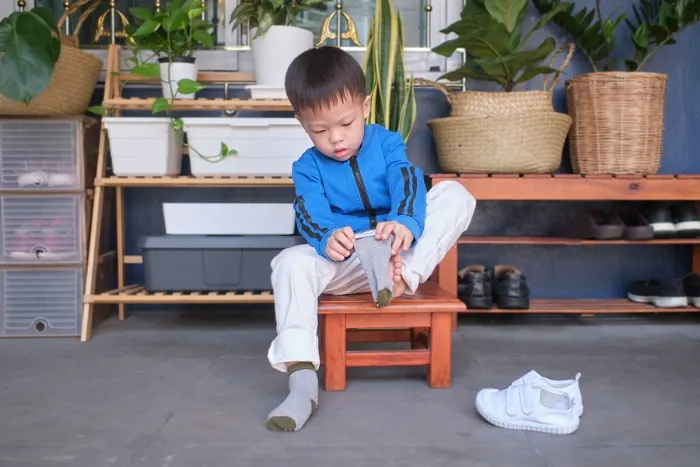Bilateral coordination is an important aspect of a child’s physical development and how they use their bodies in everyday activities.
Without this type of control, normal tasks like walking, buttoning and drawing present a huge challenge for kids.
What is Bilateral Coordination?
The definition of bilateral coordination, also called bilateral integration, is having the control to use both sides of the body in an organized way.
This coordination shows that the left and right sides of the brain are working together and communicating.
Integration is shown in activities like climbing stairs, dressing, stringing beads and cutting.
As you perform these functions, notice how each side of the body is doing something special, making the full task possible.
What is Crossing the Midline?
Crossing the midline is a skill where children can naturally move their eyes, hands, or feet across their bodies into the space of the other side.
Examples of this skill include sitting with legs crossed, reaching for an object placed on their left with the right hand, and drawing two intersecting lines with just one hand.
Children often gain this ability around ages three to four, and this is when they usually choose a dominant hand, as well.
Why is Bilateral Coordination Important?
Without bilateral coordination, many everyday tasks are very difficult for children to achieve.
For example, in order to draw a picture, one hand must hold the paper from moving while the other hand moves the pencil or crayon. At the same time, the eyes must move to the necessary areas to help guide the path of the writing tool.

Both play and daily living tasks are very difficult without bilateral integration, which involves small motor, large motor, and visual-motor functioning.
Body awareness is another ability related to bilateral coordination. This is the capability to know or have a feel for where your body parts are without always having to look, based on sensations from joints and muscles.
An example of this is knowing how far to reach for something. Kids who appear overly awkward, rambunctious, or cautious in their movements may have delayed body awareness.
The Link Between Bilateral Development and Academic Skills
Many academic skills rely on solid bilateral development.
In reading a book on their own, for example, children must learn to hold the book, turn the pages, and move their eyes from left to right, dropping down to a new line at the end of each line completed.
Writing requires many of the same abilities, in addition to guiding the pen or pencil.
Being able to cross the midline is important for smooth and natural movement during these academic activities.
What Kinds of Activities Require Bilateral Coordination?
What are some examples of bilateral activities for toddlers and preschoolers? The following gross and fine motor actions call for bilateral coordination:
- Kicking, throwing and catching a ball
- Riding a bike or trike
- Walking, running and crawling
- Cutting
- Pushing and pulling
- Stringing beads
- Drawing a line with a ruler
- Banging blocks together
- Tying shoes
- Dressing
- Feeding oneself
- Colouring

The Three Main Types of Bilateral Movements
Bilateral movement is made up of three different types. These include symmetrical, alternating, and dominant/supporting hand movements.
Symmetrical Movements
Also called symmetrical bilateral integration, this is where the left and right sides of the body exactly mirror each other at the very same time.
Examples include the following:
- Clapping hands
- Jumping rope
- Hopping like a bunny
- Rolling with a rolling pin
- Playing the drums with both hands
Alternating Movements
This is also referred to as reciprocal bilateral integration and requires reciprocal movements, in which the other side of the body performs the exact opposite action.
These activities use alternating movements:
- Climbing stairs
- Skipping and running
- Swimming
- Walking
- Riding a bike or trike
Dominant Hand and Supporting Hand Movements
Sometimes called asymmetrical bilateral integration, both sides of the body and brain are involved. The dominant hand and non-dominant hand assist each other toward a common goal.
Here are some examples:
- Cutting with scissors
- Spreading a substance onto bread
- Stringing beads
- Colouring, writing, and drawing
- Stirring
What does the Vestibular System have to do with Bilateral Coordination?
The vestibular system is located in the inner ear and includes various canals, organs and receptors.
These work together to assist the brain and eyes in processing information about balance, movement, spatial orientation and head position.
A stimulated vestibular system can be helpful in strengthening bilateral coordination. Activities you might consider for children include having them roll their bodies on the grass, perform somersaults, and jump on a trampoline.
How to Develop Good Bilateral Coordination Skills
You can find many simple bilateral games and activities throughout the course of the day. First, determine your children’s needs by being observant as to how they perform certain functions.
Keep in mind that it is common for babies or toddlers to use the hand that is positioned closest to an object. As kids reach the age of three or four, you can expect to see them crossing the midline and choosing a dominant hand.
Also notice if a child is overly clumsy or fearful of having their feet off the ground, such as in swinging, which can indicate a lack of body awareness.
Through observation, you can determine whether a child has poor bilateral coordination.
30 Bilateral Coordination Activities for Kids
Through the following kinds of bilateral integration activities, you can help children strengthen their coordination skills.
You may recognize most of these activities as just “play,” but remember, how kids learn is through play.
Symmetrical Activities
With these types of exercises, children use both hands at the same time to do the very same thing:
Painting with a Squeeze Bottle
Paint may need to be thinned with a bit of water to squeeze out easily. Fill one bottle for each colour desired.
Kids hold the bottle with both hands and squeeze it onto the target surface.
This can also be accomplished with clear water outside on a warm day, to squeeze onto the sidewalk or patio.
Blowing and Popping Bubbles
Use homemade or purchased bubble solution with bubble wands or straws.
Adults blow the bubbles and kids pop them between both hands. With a group of children, they could take turns blowing the bubbles.
Rolling with a Rolling Pin
children first squeeze the playdough with both hands, which is a symmetrical activity. Then holding the handles on both ends of the rolling pin, they press down and roll the pin to flatten the dough.
This can be accomplished using playdough or a real pastry with an adult.
Pulling Cotton Balls Apart
Grasp one cotton ball at a time with the fingers of both hands and pull them apart.
These are great to use later on in glueing art activities.
Pulling Up Clothing
Certain types of clothing lend themselves well to this activity, such as pants and socks.
Kids grip the article with the fingers of both hands and pull it up while dressing.
Tearing Strips of Paper
All kinds of paper may be used for this activity. Challenge your kids to tear strips as straight or as curly as possible.
These are very useful later on in glueing art projects.
Bouncing and Catching Balls
Bounce large playground balls and catch them with both hands.
This can be played individually or as a partner/group activity.

Performing Jumping Jacks
Show children how both their feet/legs and both arms/hands do the same thing while performing jumping jacks.
For added enjoyment, these can be done to music.
Playing on Toy or Real Instruments
Offer instruments that lend themselves well to using both hands in the same way, such as percussion instruments.
Certain aspects of accordions are also symmetrical.
Alternating Activities
In alternating activities such as those that follow, your children use the opposite hand/arm or foot/leg in alternating motion:
Climbing a Ladder
Many playgrounds offer safe opportunities for children to climb ladders. Have them practise climbing both up and down.
Playing the Drums with Alternating Hands
Model a rhythm for kids with alternating hands. Challenge them to copy your beat.
Marching
Marching is like exaggerated walking and draws focus to the movements. For added fun, plan a parade.
Air Biking
Show kids how to lie on their backs and pedal their legs in the air.
This is an enjoyable activity to pair with music.
Playing Follow the Leader
Play Follow the Leader by modelling any type of alternating movements, such as hopping on one foot and then the other for a certain number of times.
This offers counting practice, as well.
Playing Tug of War
As children tug on the rope, they use an alternating, hand-over-hand motion.
Two adults can take part at the ends to make sure youngsters on both “teams” have plenty of strength behind them to experience the tugging motion.
Activities that Require Different Skill Sets for Each Hand
These exercises require a dominant hand and a “helper” hand to perform the tasks:
Lacing Cards
Make your own or buy a set of lacing cards.
Using shoelaces with plastic ends, lace from one hole to the next, following the outline of the illustration on the card. One hand holds the card while the other guides the lace.
Tying Shoes
Encourage children to practise tying their shoes by making loops or “bunny ears” and wrapping the lace around and through while holding with the other hand.

Spreading or Frosting
While holding the bread, cracker, or cookie with one hand, spread or frost using a blunt knife or spreader with the other hand.
Tracing Around Stencils
Buy sets of stencils or make your own cut from cardboard or poster board.
Children hold the stencil on the paper with one hand and trace around it using a pencil or crayon with the other hand.
Cleaning Up
Use a toy broom in one hand and a dustpan in the other to help clean up after an art activity.
These may also be used to pick up small toys such as Legos.
Sewing for Kids
Use your own materials or buy a prepared kit.
Using stiff fabric such as felt, your children can “sew” with a blunt needle and yarn through pre-punched holes.
Create various patterns on the fabric, such as straight lines and zigzags.
Activities for Developing Body Awareness
If a child needs the practice to build awareness of the sensations and locations of their various body parts, these types of activities can help:
Playing Simon Says
With a focus on body parts, give commands such as, “Simon says touch your knee.”
For young children, you may want to skip the part about a child being “out” if you had not said, “Simon Says,” first.
Here are some other great ways to play Simon Says.
Playing Follow the Leader
The leader touches various locations on their own body and names the parts. Children follow their lead and name parts of the body.
Playing Hokey Pokey
Sing the song as a group and/or play the music. Follow the directions given in the song.
Instead of facing the children, stand alongside them to help with the left vs right factor of the song.
Taking Part in Wheelbarrow Walking
In pairs, children take turns walking on their hands while the other holds their feet/legs and “drives” the wheelbarrow.
Moving Like Animals
Ask for ideas on how snakes, crabs, bears, inchworms, birds, and gorillas move. Talk about the body parts and what they are doing.
Then have fun practising.
Drawing Pictures of Bodies
Challenge your children to draw pictures of themselves or other people. Then have them name the various body parts, while you label them.
Moving Through Obstacle Courses
Indoors or outside, set up simple obstacle courses with various materials and equipment.
Your kids can walk, run, and crawl to go under, over, around, and through objects.
Pushing, Pulling and Carrying Objects
Get children to move heavy objects, which makes them more aware of their bodies and capabilities.
This is also a good activity for building strong muscles.
Playing Shake Your Wiggles/Sillies Out
Play this game to the words in related music or with an adult’s directions. Urge kids to shake the wiggles or sillies out of one body part at a time.
Playing What’s My Body Part?
Describe different body parts and their functions to your children. They can guess which body part you are referring to.
Older children could also take turns describing.
I hope you enjoyed these bilateral coordination ideas for kids. All aspects of their busy days, as they play, “work,” and assist, can involve practice in these important types of movements.

Sources:
https://www.childsplaytherapycenter.com/bilateral-coordination-important/
https://www.yourtherapysource.com/blog1/2017/10/01/bilateral-coordination-skills/
https://www.theottoolbox.com/bilateral-coordination-activities/
https://www.acecic.co.uk/media/1118/the-vestibular-system.pdf
